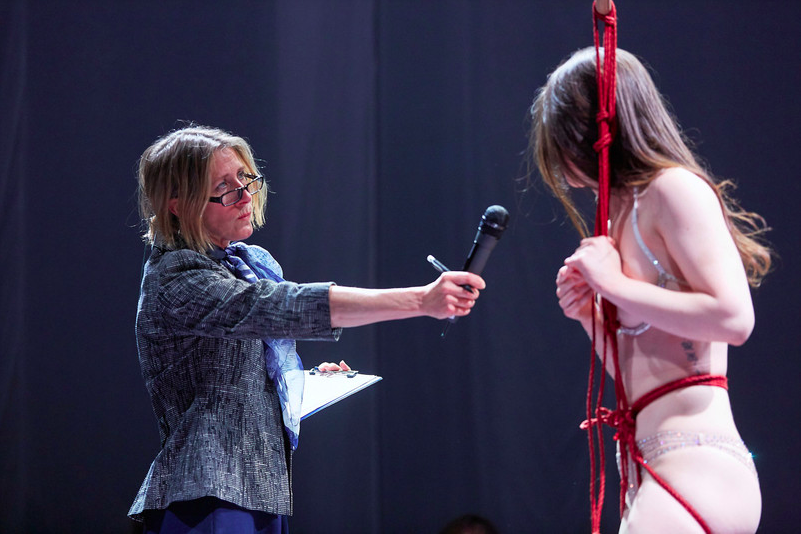Review from: Summerhall, Edinburgh Festival Fringe; 16th August 2019
‘Art should be uncomfortable, otherwise it’s merely decoration‘ – quotes a character in one of many quotations given to us as rapid fire food-for-thought in Shasha & Taylor‘s debut production. True to these words, Everything I See I Swallow makes its audience uncomfortable right at the start: as we file into the space, we’re welcomed by a topless young woman, tied up and suspended from the ceiling in knotted shibari. This was not to be a comfortable show… and how lucky were we.
The concept is quite simple: an unnamed mother (Tamsin Shasha) discovers her daughter Olivia (Maisy Taylor) has a popular instagram account where she shares suggestive photos of herself tied up, blind-folded, nude and in otherwise compromising positions. The mother, a self-proclaimed feminist, then challenges her daughter on her choices. The show wrestles with some pretty difficult questions: Who does our body belong to when we share it? Is blatant sexuality a feminist act? What do past and present generations owe each other?
The show’s power lies in these very political conversations, because as the mother herself cites: ‘the personal is political‘. Our individual choices do not exist in a vacuum, they are deeply entangled in the politics of our days, and in the politics that came before us. As the mother’s second-wave feminism clashes with her daughter’s third-wave feminism, we are challenged to consider how political the personal actually is. One the one hand, the mother – a product of a movement that fought for women to be judged for their character and not for their looks – is having a difficult time fathoming how her daughter’s ‘pornographic’ photos can be a form of women’s liberation. On the other hand, Olivia is attempting to reclaim her body and feels misunderstood by a mother who thinks it’s just another form of rape culture and female oppression. But would reclaiming one’s sexuality be possible if it wasn’t for the women who first said ‘we are more than our bodies‘? And would fighting to see women appreciated for their minds not have been pointless if it meant women can’t celebrate their bodies? Just like a mother and daughter have these titles because the other exists, so do their feminist approaches depend on one another’s existence.
But do not be confused… this show is not a political debate. Though the script is text-heavy (and rather clunky at times? – Ed.), director Helen Tennison excels at combining text and movement, and the show’s beauty lies in how the movement mirrors, contrasts and accentuates the emotional struggles of its characters. This is quite an accomplishment, and one many other (supposedly) narrative circus shows attempt to achieve but fail: the seamless meeting of a story and its physical embodiment. The aerial choreography is not about the tricks, it is there to elevate the narrative and is wisely woven in and out of the story, offering a beautiful yet painful circus-theatre musing on being a woman in today’s society.

The red shibari cords visually connect the characters’ storylines to the more traditional circus apparatus. The mother has a smooth, white aerial rope, while the daughter’s is black and, without casing, more rough on the skin. When they take to the air they frequently mirror each other but using opposite limbs – similar yet different to each other; and the show’s final rope act – where both characters share one rope in an intricate aerial duo, supporting and lifting each other up – is the perfect symbol of a mother-daughter relationship. This climax is preceeded by a battle of quotes, where each character reaches for various feminist thinkers, from Margaret Atwood to Story of O, from Jane Eyre to Beyoncé. The quotes are projected in the background, at first sharing the space but eventually piling atop each other, words obscuring words, battling for space, fighting to be seen. Such a potent representation of how thought begets thought, of how each idea stems from what came before.
Fierce, unapologetic, thought-provoking and radical as fuck, Everything I See I Swallow may not be the circus show you wanted, but it’s the circus show you needed. It proves that circus doesn’t have to choose between entertaining and meaningful – it can hold onto both concepts and then some. It can showcase physical strength and flexibility without compromising a powerful message; it can show us what the human body can accomplish while also challenging us to consider what our minds can achieve.




